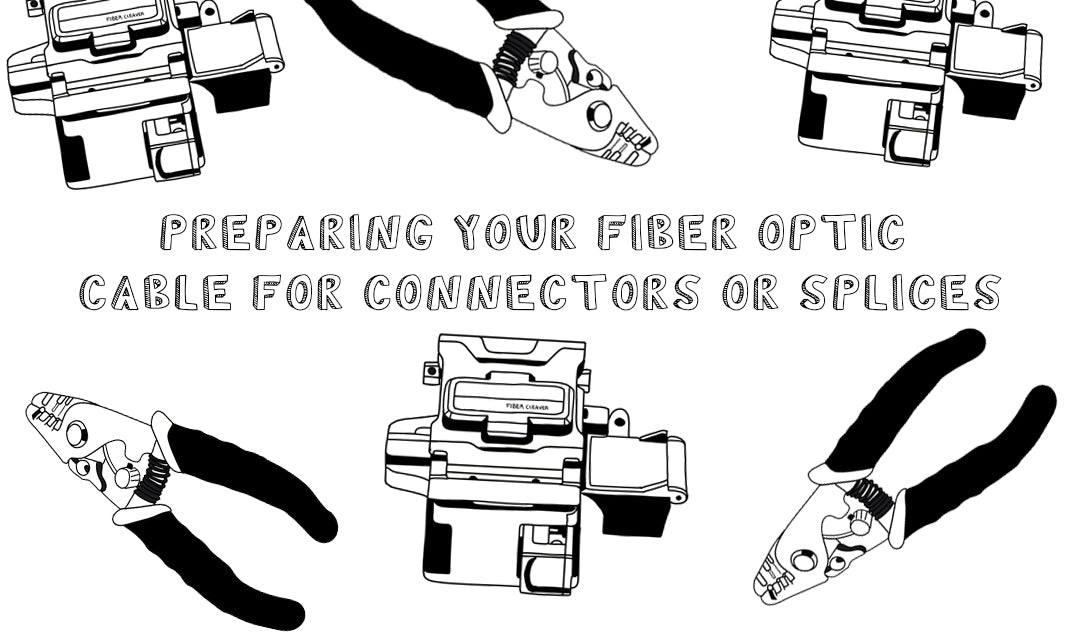Payment methods accepted

Preparing your Fiber Optic Cable for Connectors or Splices
Written by Ben Hamlitsch, trueCABLE Technical and Product Innovation Manager RCDD, FOI
At the heart of any robust fiber optic network lies a crucial process: Preparing a fiber cable for termination of a connector or splice. Two types of splices are used in fiber optic cabling one is Mechanical the other is Fusion. Whether you're installing a new network, expanding an existing one, or performing maintenance, the ability to properly prepare, connectorize or splice fiber optic cables is an essential skill for any technician or fiber network engineer.
Fiber optic splicing is the art and science of joining two separate optical fibers to create a continuous light path. This process requires precision, patience, and a deep understanding of the delicate nature of optical fibers. Before any splicing can occur, whether it's mechanical or fusion splicing, the fiber optic cable must be meticulously prepared.
The preparation process is far more than just stripping away layers of protective coating. It involves a series of carefully executed steps, each critical to ensuring a low-loss, high-quality splice. From removing the outer jacket to cleaning the bare fiber and achieving a perfect cleave, each stage demands attention to detail and the use of specialized tools.
In this guide, we'll walk you through the entire process of preparing fiber optic cable for splicing and termination to fiber connectors. We'll explore the necessary tools, safety precautions, and step-by-step procedures for cable connectors, mechanical and fusion splicing methods. Whether you're a seasoned professional looking to refine your skills or a newcomer to the field seeking to understand the fundamentals, this guide will provide you with the knowledge and insights needed to master these critical steps of fiber optic installation.
In this article we are going to discuss the general preparation steps and tools required for both techniques. These steps will ensure the fiber optic cable is ready to either connectorize, mechanical or fusion splice.
Gathering the necessary tools for Fiber Optic splicing
It is important to ensure that you have the proper tools when it comes to preparing fiber optic cable for either connectors, mechanical or fusion splicing. There are a variety of tools out there and some like everything, better than others. When searching, stick to the well known brands in the fiber industry or look for tools that have had good reviews and feedback from actual users of those tools.
- Fiber optic stripper
- Strength Member Cutters (Kevlar Cutters)
- Lint-free wipes
- Fiber optic cleaning solution
- Fiber optic cleaver
- Safety glasses
- Work mat
- Fiber Shard Container
Always handle fiber optic strands with care. Fiber safety is not only important but can be hazardous to health if it was ingested or enters the skin when working with fiber cable. Dispose of fiber scraps immediately in designated disposal units to prevent physical injuries. Due to the thin strands of glass or plastic that constitute these cables, breakages can result in tiny, almost invisible shards. It's paramount that technicians and handlers wear protective gloves when working directly with fiber optics to prevent these shards from embedding into the skin. Furthermore, it's always advisable to work in well-lit areas to easily spot and manage any broken fibers, ensuring that no fragments are left behind after operations.
When it comes to disposal, one cannot treat fiber shards as ordinary waste. Given their potential to cause harm, these shards should be collected using adhesive tape or specialized waste containers designed for fiber debris. Once collected, they should be disposed of in clearly marked containers or bags labeled "Fiber Waste" to alert others to the potential hazard. Regularly inspecting the work area and ensuring that all remnants of the fiber optic cables are safely contained and discarded can prevent inadvertent exposures and injuries while also ensuring an environmentally responsible disposal process.
Always wear safety glasses to protect your eyes from fiber shards. Dispose of fiber scraps properly in a designated fiber shards container. Work in a well-lit, clean area to avoid contamination.
Steps for Preparing Fiber Optic Cable
In this example we are going to show how to prepare a fiber optic indoor 2mm or 3mm cable. However depending on the type of cable, this can vary whether it is armored or outdoor, has a loose tube or tight buffer. This example covers many of the basic steps for indoor tight buffer cable types.
In these examples we are showing how to remove the jacket Kevlar Aramid Strand, buffer and acrylate coating using a 3 hole stripper tool pictured below. The first 3 steps will use this tool. There are many tools when it comes to stripping fiber optic cable and ways of doing it. This is just one example.

Step 1: Removing the outer jacket
- Use a fiber optic jacket stripper to remove the outer protective coating.
- Carefully score the jacket without damaging the inner buffer coating.
- Remove the jacket at the scored location of the jacket to expose the aramid strand and fiber strands. (note this may look different inside depending on the type of fiber cable used.)
- Next, cut off the Aramid (Kevlar) strength member.
The tool pictured below is used for removing the aramid strength member. The reason for using a different tool is the tool needs to be a very sharp pair of cutters that are designed to remove this kind of strength member. After all this is Kevlar, the same thing that is used in bullet proof vests. It is extremely strong and designed to protect the cable from damage or breakage. For this reason a specialized type of cutter is designed and needed for this step.


Step 2: Removing the buffer coating
- Use the 900um buffer remover which is the second hole on the 3 hole stripper.
- For mechanical stripping, place the fiber in the appropriate sized groove of the buffer removal tool.
- Gently pull the tool along the fiber buffer to remove the buffer coating. This is best done in ¼ inch increments so as not to break the fiber cable.
- For chemical stripping, follow the manufacturer's instructions for the specific product.
Step 3: Removing the acrylate coating
- Use the last hole on the 3 hole fiber stripper tool.
- Slowly slide the tool across the 250 um fiber.
- Acrylate coating will start to peel off the fiber stand.
- If needed, make 1 or more passes to remove the acrylate coating.
Now that the bare fiber has had the Jacket, 900um buffer and the acrylate coating removed the bare fiber is now exposed and ready for the next step in the process.
Step 4: Cleaning the bare fiber
This step of cleaning the bare fiber is a very important step to ensuring the fiber is clean and free of dust or lint, before it is cleaved.
Cleaning BEFORE cleaving is important, but not AFTER cleaving. There is nothing cleaner than the end-face of a newly-cleaved fiber.
Fiber never should be cleaned after cleaving. If you do, the fiber end-face will be contaminated. This will cause extra work for the fusion splicer in the pre-burn phase, shorten the lifespan of the unit's electrodes, degrade the mechanical strength of the splice in the form of non-linear splices with bubbles, and cause excess signal losses.
If you’re splicing, it’s very important to clean the fibers before cleaving. A common misconception is that one does not need to be concerned about cleaning except at the very end of the connector assembly process. Not true. Cleaning the fiber ahead of time removes any remaining debris from the stripping process plus any other contaminants that may be on the fiber. Once the coatings have been stripped off from the fiber, it needs to be cleaned off with a damp, lint-free wipe. The liquid used to dampen the lint-free wipe must dry fast to prevent any liquid from remaining on the fiber. Below you can find the process to ensure proper fiber cleaning.
- Use a lint-free wipe dampened with fiber cleaning fluid.
- Gently clean the exposed fiber to remove any debris or residue.
- Be careful not to touch the cleaned portion of the fiber.
- As you clean the fiber you will hear a soft squeaking sound. This is a good indicator that the fiber is clean and any dirt or debris is clear.

Step 5: Cleaving the fiber
Fiber optic cleavers are precision instruments used to create a clean, perpendicular cut on the end of a fiber. This is crucial for both mechanical and fusion splicing. Types of cleavers include:
- Hand-held cleavers
- Bench-top cleavers
- Precision angle cleavers

Always work in a clean environment to avoid contamination. Practice proper fiber handling techniques to prevent damage. Regularly maintain and check any tools you use for damage to ensure they are ready to use and will not cause issues when performing your fiber optic work. Below you can find the process to ensure proper Fiber Optic cleaving
- Place the stripped and cleaned fiber in the fiber optic cleaver.
- Ensure the fiber is positioned correctly according to the cleaver's instructions.
- Activate the cleaver to create a precise, perpendicular cut on the fiber end.
- Select the appropriate groove size for your fiber.
- Place the fiber in the groove and close the tool.
- Gently pull the tool along the fiber to remove the buffer coating.

Fiber Optic Splicing
Generally, there are two methods to splice optical fiber cable: (1) mechanical splicing; (2) fusion splicing. Choosing the splicing method can depend on the fiber optic performance required for any given installation. See Fiber Optic Splicing: Examining the Factors that Affect Splice Performance
Mechanical Splicing
If you want to produce a mechanical connection, you need to put inline splice quick-connect fiber-optic connectors to the fiber. Hold the two fiber ends in a precisely aligned position thus enabling light to pass from one fiber into the other. (Typical loss: 0.3 dB)
Fusion Splicing
In fusion splicing, a fusion splicer is used to precisely align the two fiber ends. You have to convey a fusion splice protector to the fiber, and place the fibers which are spliced within the fusion splicer. Then, the fiber ends are “fused” or “welded” together using some type of heat or electric arc. This produces a continuous connection between the fibers enabling very low loss light transmission. (Typical loss: 0.01 dB)
Conclusion
In conclusion, the meticulous preparation of fiber optic cables is a critical process that underpins the success of both mechanical and fusion splicing operations. Each step, from the careful stripping of protective layers to the precise cleaving of the fiber, requires an in-depth understanding of the tools and techniques involved. Proper handling and cleaning are essential to ensure low-loss connections and the long-term reliability of the fiber network. By adhering to the outlined procedures and maintaining a clean, well-organized workspace, technicians can achieve optimal performance, resulting in robust and efficient fiber optic networks.
HAPPY NETWORKING!
trueCABLE presents the information on our website, including the “Cable Academy” blog and live chat support, as a service to our customers and other visitors to our website subject to our website terms and conditions. While the information on this website is about data networking and electrical issues, it is not professional advice and any reliance on such material is at your own risk.



























